

We arrived in Italy at Naples Airport and then hired a car to drive to Pompeii.
At Pompeii we stayed at the Camping Spartacus campsite, which is to the right of the main square as you enter Pompeii through the Toll Gates. We thought this was one of the best sites in the area, with individual plots bound on three sides with trees and bushes and space by the tent to park the car. However there are a few in the area so you should have no problem finding a reasonable one.
After setting up the tent we went across the square and up the ramp to the Ruins(Scavi) Entrance.
(We couldn't wait until the next day for our first visit as we had planned to do.  )
)
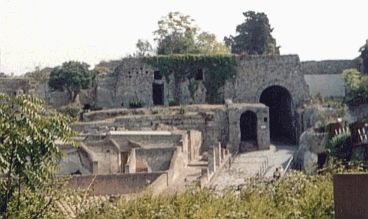
We began the Tour at the City gate (Porta Marina) through which ran the road to the sea. The ramp leading upto the gate is on quite an incline and it must have been a bit of a push taking carts up it.
This is the street that leads up from the gate towards the Forum (Piazz del Foro), past the much ruined Temple of Venus (Tempio di Venus) and the Basilica on the south side and towards the Temple of Apollo (Tempio di Apollo) on the north side.
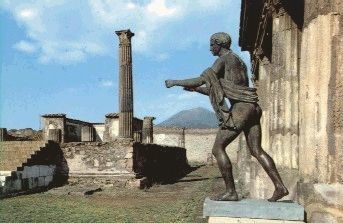
This is quite a large building with a portico around the outside of a central courtyard with the actual temple in the centre up a small flight of marble steps.
The two statues in the courtyard are copies of Apollo the Archer and Diana, the originals of which are in the Museo Archeologico Nazionale in Naples.
There is very little left of this temple as it has been mostly destroyed by subsequent earthquakes and the land has fallen away down the hill. It's probably best to see this on the way out as all that remains is a lot of column sections and miscellaneous blocks of masonry strewn randomly about.
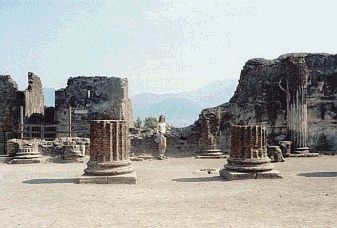
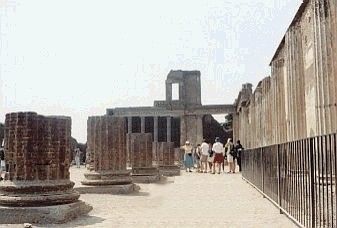
This was the Law Court and trade administration centre for Pompeii, originally it would have had a sloping roof supported by the rows of columns. Opposite the entrance is a raised area where the magistrates would have sat. Lots of ancient graffiti here on the side walls.
This was the centre of the city's political and religious life it was also where one of the markets were held.
As you can see by the columns there used to be a portico around the Forum with two archways at the Northern end. Unfortunately only one of these survives.
Incidentally the red roofed building at the far end is a café with toilets and a shady eating area, good to stock up on water and cool down.
Built in the 2nd Century B.C. it could house upto 5000 people after it was enlarged during Augustus's reign as Emperor. This complex also contained a large quadrangular portico behind the stage.
Also within this complex was another small theatre, also known as the Odeon which was used for concerts and poetry readings.
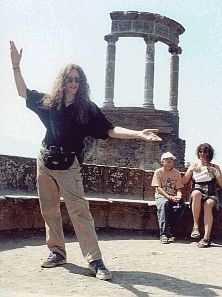 |
The Street of the Sepulchres(Via dei Sepolcri) is a large street, leading through the Porta Ercolano in the North-East corner of the city, lined with Tombs and Monuments of the deceased from the city right through to A.D. 79.
At the end of the Street the Villa of the Mysteries is reached under an avenue covered with vines and over a small foot-bridge which runs over what used to be some sort of moat as it was built right next to the sea, I think.
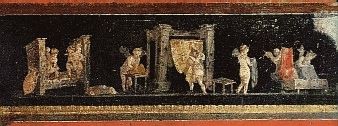 |
| Click the Picture for More. |
The Villa of the Mysteries(Villa dei Misteri) is possibly the most intact building in Pompeii as most of the roof survived the Eruption.
It was built around the 2nd Century B.C. on a slope facing the sea and was the summer residence of a well-to-do family.
N.B.: Don't leave the exit near the villa to go to the stalls outside the fence without first telling the guys on the gate as it can be very difficult to get back in.(Especially if your Italian isn't up to it.)
 |
This is a pretty typical Roman house in Pompeii. The facade contained three shops, a tavern and a bakery, with the entrance running between two shops. It may also have been used as a sort of hotel, due to it's proximity to the Porta Ercolano.
The entranceway is marked by this mosaic of a dog, it is not the famous "Beware of the Dog"(Cave Canem) one in the House of the Tragic Poet, but runs along a similar theme.
In a time when alot of people probably couldn't read "a picture tells a thousand words" to paraphrase slightly. Perhaps the shield and axe indicated the owner was a warrior of some sort.
Unfortunately we could not get any further in than this as there was a rope across the doorway.
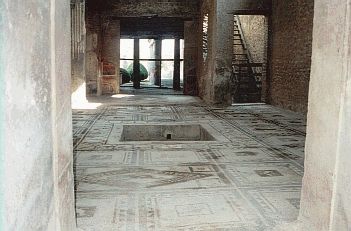 |
You can see the shallow basin(impluvium) used to collect rain water from an opening in the roof(compluvium) which also served to provide light and air.
Beyond that is the reception room(tablinum) this originally would have had a screen of wood or canvass which could be drawn to provide a little privacy.
Then through to the porticoed garden(peristylium), many of which had a small shrine(lararium) at the far end dedicated to the household gods(Lares). The stairs to the right led to the next floor where the bedrooms were situated.
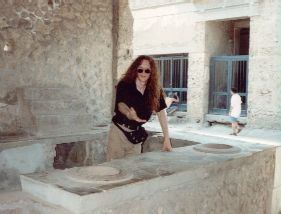 |
These were the Roman version of "take-away" shops, although a few had small areas to eat-in at the back, and there are literally loads of these throughout Pompeii. Virtually every block has at least one, most have two or three.
The counter in this one, which is on the Via Stabiana,was faced with dressed stone on the street side, with large stoneware pots set into it. The pots were for food storage and are quite deep and wide. Some had openings below, possibly for small fires to keep certain items warm.
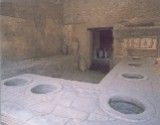
The one in the small picture on the right is The Thermopolium of Vetutius Placidus on the Via Dell'Abbondanza. In the back wall is a shrine with the figures of Mercury, the god of profit, and Dionysis, the god of wine. The owners quarters were situated at the back.
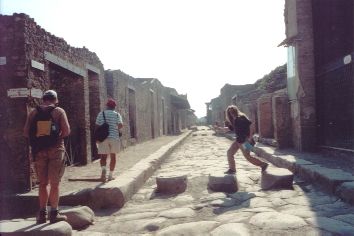 |
This is me on the Via Stabiana fulfilling a life-time ambition. Ever since seeing these stepping stones in a history lesson when I was about 11, I'd wanted to see these streets and walk across some of these stones. Hence the "Beatles Abbey Road" pose.
At most of the main junctions there are these stepping stones to allow the public to cross without getting their feet muddy if it was wet. The gaps are set at the same width as what must have been some Roman standard cart width to allow the carts to pass through.
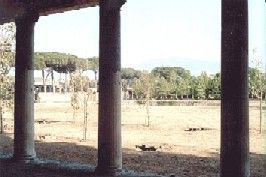 |
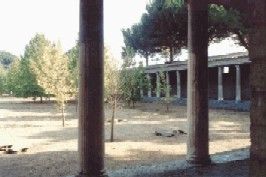 |
This was built in the Augustan era and used for sports activities. It measured 147m x 107m, was roofless and bounded on three sides by a colonnade. There was also a huge pool in the middle surrounded by rows of trees. You can just see the Amphitheatre through the trees to the left.
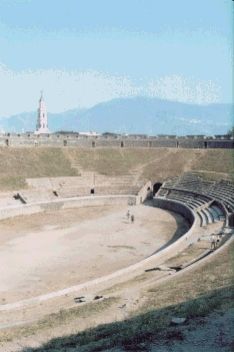 |
This is situated right next to the Gymnasium and was built in 70 B.C. for gladitorial combats. It seated about 20,000 and like the Colosseum in Rome had a linen canopy drawn over the spectators in summer. In 59 A.D. there was a riot between rival supporters from Nocera and Pompeii which resulted in many people being wounded or killed. The events were suspended for 10 years but actually began again after the 62 A.D. earthquake.
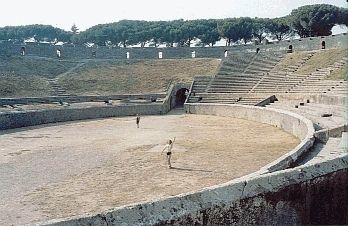 |
Me being rather silly, again, running round the Amphitheatre. Much to the bemusement of passers by who could not see my girl-friend taking the pictures.
After this we just walked back along the south wall of the city as it was nearly closing time. On the way back we stumbled across the Fugitives Garden.
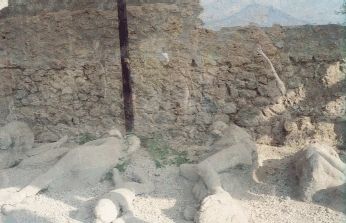 |
| Click the Picture for More. |
The Fugitives Garden(Orto dei Fuggiaschi) is actually a vineyard where they are trying to grow some ancient grape varieties at present. There are 13 bodies situated against the inside of the south wall in a glass case to protect them. Note the rather ominous reflection of Vesuvius in the top right of the glass.
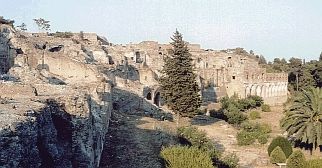 |
This was taken on our way out and shows the outer wall with its arched wall supports. There are also some entrance ways, now sadly blocked, which I assume lead up into the city. There are also some benches and the gardens have been landscaped making quite a pleasant place to sit in the evening and enjoy a bottle of wine.